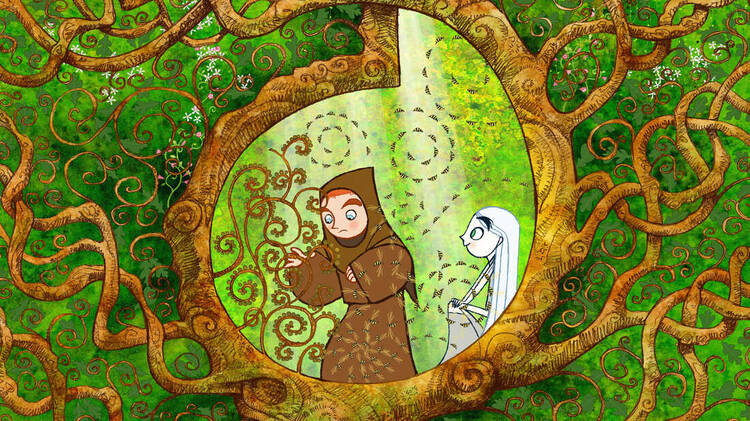Most historians will tell you that “the Dark Ages” is a misnomer. While earlier scholars considered the period of European history immediately following the fall of Rome a time of brutish violence and cultural decline, in the modern era, we have become more aware of this historical period’s advances and accomplishments. People still created, invented, built, dreamed. That’s one of the most praiseworthy aspects of human nature, and a good description of faith: in dark times, some people will always look for matches.
“The Secret of Kells” takes place in ninth-century Ireland, squarely in the supposed Dark Ages and at a time when the island was plagued by marauding bands of Vikings. The film, the first feature produced by Irish animation studio Cartoon Saloon and director Tomm Moore, tells a fantastical account of the creation of one of that age’s greatest works of art: the Book of Kells, a book of the Gospels meticulously hand-illuminated by Irish monks.
The book arrives in Kells, Co. Meath after the monastery at Iona is plundered by raiders, carried by master illuminator Brother Aidan (played by Mick Lally). Kells is more a fortress than a monastery, a single stone tower ringed by constantly under-construction walls that reach high enough to block out the surrounding forest. Abbot Cellach (Brendan Gleeson) believes that “[i]t is with the strength of our walls that [people] will come to trust the strength of our faith,” and has no time for anything as ethereal as beauty or art; his primary interest is survival. But Aidan finds a more receptive audience in Cellach’s orphaned nephew, Brendan (Evan McGuire), a 12-year-old monk with a curious and adventurous nature.
Enchanted by Aidan’s beautiful in-progress book, Brendan ventures beyond Kells’ walls to find materials to create ink, despite his uncle’s warnings that the woods are pagan and full of danger. He’s not wrong, although Brendan also makes a surprising friend: Aisling (Christen Mooney), a fairy who has also lost her family. Together they take on various obstacles—including an ancient Celtic god of darkness and the implacable approach of the Vikings—in order to finish the book’s Chi-Rho page which, Aidan says, will “turn darkness into light.”
The Chi-Rho page is an intricate painting of the Greek letters that begin Christ’s name, the Savior’s monogram (not to spoil anything, but you can see the real page here). For the characters in the film and their beleaguered countrymen, it represents hope, new life, a light that shines in the darkness. As John writes about Christ at the beginning of his Gospel: “The light shines in the darkness, and the darkness has not overcome it” (Jn 1:5). That light of Christ is alive in the human heart during dark times, urging us towards rebirth, lighting the spark that warms us through the long night.
I knew I wanted to cover an Irish movie this week before St. Patrick’s Day (as you can tell from my last name, the holiday has some personal significance to me), and to me “The Secret of Kells” embodies the spirit of Irish history. Despite years of oppression, violence and civil war, the Irish people continued to create beautiful things. So many great Irish folk songs (and later, the tradition of Celtic punk) sprung from hard times, as the Irish transformed their pain into something that could enrich their lives. The Irish are hardly the only example: the tradition of African-American spirituals arose from enslaved people in the American South, and camp developed as a response to the rejection and persecution of the L.G.B.T.Q. community. When we create, we refuse to let darkness have the final say.
That’s because creation, art and beauty are the things that make survival worth it in the first place. They remind us of the sacred and call us to imagine a world beyond our suffering, a world where better things are possible. In the film, Abbot Cellach is obsessed with survival for its own sake, believing that stout walls and a suspicious nature are the answer. He has no time for Brother Aidan’s book because art, in his way of thinking, is useless. In a sense, it is: a painted page won’t drive off the wolves or stop a Viking sword. But a life enclosed by walls, focused only on the grim work of making it to the next day, isn’t a life worth living. When Brendan first approaches the woods, the animators shape the treeline with swooping arcs and circles, calling to mind the tall stained glass windows of a cathedral. He comes to realize that while the forests aren’t nearly as safe as the monastery, they’re also the place where the sacred truly dwells.
Every era of human history, and every human life, has periods of darkness. But there’s a reason that people write poems on the battlefield, paint portraits during plagues and sing songs as bombs fall around them. Beauty is not “useful” the way that a wall or a weapon is, but it is the only one of those things that makes life worth living. It’s what connects us, even in our suffering, to the redemptive hope of the Resurrection. Even in the darkness, a light shines.
“The Secret of Kells” is streaming on Kanopy.








